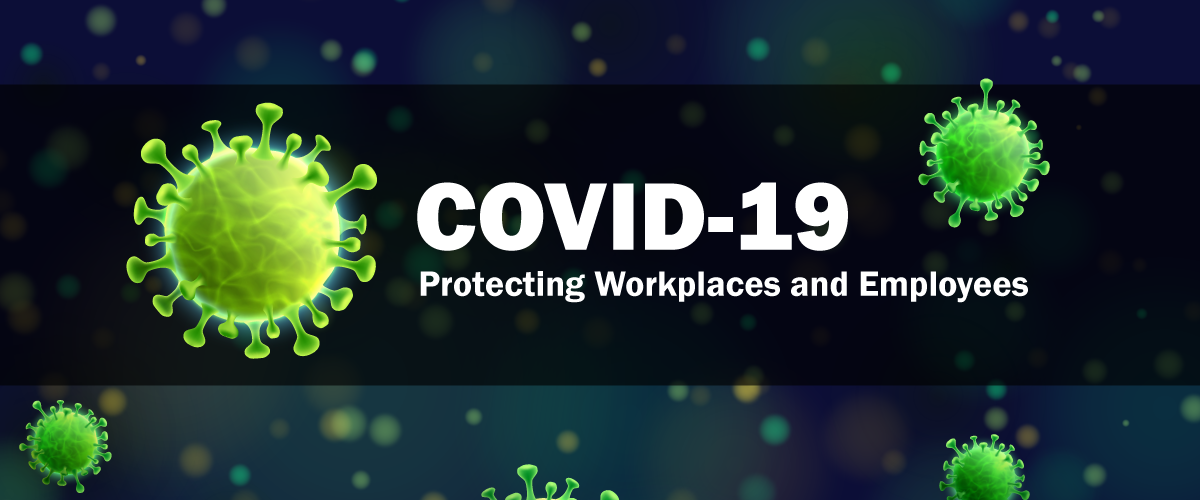
6 years ago
·
by
Joyce Insurance ·
Comments Off on COVID-19: Protecting Workplaces and Employees
PA Training for Health & Safety Accident Prevention Through Education
Purpose
To provide guidance for businesses and employers on how to plan for and respond to Coronavirus Disease 2019 (COVID-19). This guidance is based on what is currently known about the coronavirus disease 2019 (COVID-19). COVID-19 is a respiratory illness that can spread from person to person. The outbreak first started in China, but the virus continues to spread internationally and in the United States. The following guidance is meant to help prevent workplace exposures to COVID-19, in non-healthcare settings.
Reference: https://www.cdc.gov/coronavirus/2019-ncov/index.html
Preparing Workplaces for a COVID-19 Outbreak

Businesses and employers can prevent as well as slow the spread of COVID-19. Employers should plan to respond in a flexible way to varying levels of disease transmission in the community and be prepared to refine their business response plans as needed. According to the Occupational Safety and Health Administration (OSHA), most American workers will likely experience low (caution) or medium exposure risk levels at their job or place of employment. Reference: OSHA guidance for employers for more information about job risk classifications.
Businesses are strongly encouraged to enforce the mitigation strategy disseminated by the governor and the Pennsylvania Department of Health to help lessen the impact of COVID-19.
All employers need to consider how best to decrease the spread of COVID-19 and lower the impact in their workplace
This should include the following areas:
- Cleaning AND disinfecting frequently touched objects and surfaces such as workstations, keyboards, telephones, handrails, and doorknobs. Dirty surfaces can be cleaned with soap and water prior to disinfection. To disinfect, use products that meet EPA’s criteria for use against, the cause of COVID-19, and are appropriate for the surface
- Provide disposable wipes so that commonly used surfaces (for example, doorknobs, keyboards, remote controls, desks, other work tools, and equipment) can be wiped down by employees before each use to help reduce transmission among employees
Reference: https://www.cdc.gov/coronavirus/2019-ncov/community/guidance-business-response.html
What can employees do to reduce the spread of COVID-19
- Employees can take steps to protect themselves at work and at home. Older employees and people with serious chronic medical conditions are at higher risk for complications.
- Stay home if you are sick, except to get medical care. Learn what to do if you are sick
- Inform your supervisor if you have a sick family member at home with COVID-19
- Wash your hands often with soap and water for at least 20 seconds. Use hand sanitizer with at least 60% alcohol if soap and water are not available
- Avoid touching your eyes, nose, and mouth with unwashed hands
- Cover your mouth and nose with a tissue when you cough or sneeze or use the inside of your elbow. Throw used tissues in the trash and immediately wash hands with soap and water for at least 20 seconds. If soap and water are not available, use a hand sanitizer containing at least 60% alcohol. Learn more about coughing and sneezing etiquette on the PA Department of Health website.
- Avoid using other employees’ phones, desks, offices, or other work tools and equipment, when possible. If necessary, clean and disinfect them before and after use
- Follow the policies and procedures of your employer-related to illness, cleaning and disinfecting, and work meetings and travel
Reference: https://www.cdc.gov/coronavirus/2019-ncov/community/guidance-business-response.html
Employers should enforce policies and practices for social distancing
Social distancing should be enforced. Social distancing means maintaining distance (approximately 6 feet or 2 meters) from others when possible (e.g., breakrooms and cafeterias).
It is critical to emphasize that maintaining 6-feet social distancing remains important to slow the spread of the virus. American College of Occupational and Environmental Medicine (ACOEM) encourages the use of face coverings in the workplace where respirators have not historically been required to help prevent people who may have the virus and do not know it from transmitting it to others. Strategies that business could use include:
- Implementing flexible worksites (e.g., telework)
- Implementing flexible work hours (e.g., staggered shifts)
- Increasing physical space between employees at the worksite
- Increasing physical space between employees and customers (e.g., drive through, partitions)
- Implementing flexible meeting and travel options (e.g., postpone non-essential meetings or events)
- Downsizing operations
- Delivering services remotely (e.g. phone, video, or web)
- Delivering products through curbside pick-up or delivery
Reference: https://www.cdc.gov/coronavirus/2019-ncov/community/guidance-business-response.html
Assess your essential business functions and the reliance the community has on your services or products
- Change your business practices to maintain critical operations (e.g., identify alternative suppliers, prioritize existing customers, or curbside pickup)
- Talk with companies that provide your business with a contract or temporary employees about the importance of sick employees staying home and encourage them to develop non-punitive leave policies
- Talk with business partners about your response plans. Share best practices with other businesses in your communities (especially those in your supply chain), chambers of commerce, and associations to improve community response efforts
Reference: https://www.cdc.gov/coronavirus/2019-ncov/community/guidance-business-response.html
Determine how you will operate if absenteeism spikes from increases in sick employees, and those who stay home to care for sick family members
- Plan to monitor and respond to absenteeism at the workplace
- Implement plans to continue your essential business functions in case you experience higher than usual absenteeism
- Prepare to institute flexible workplace and leave policies
- Cross-train employees to perform essential functions so the workplace can operate even if key employees are absent
Separate sick employees
- Employees who appear to have symptoms (i.e., fever, cough, or shortness of breath) upon arrival at work or who become sick during the day should immediately be separated from other employees, customers, and visitors and sent home
- If an employee is confirmed to have COVID-19 infection, employers should inform fellow employees of their possible exposure to COVID-19 in the workplace but maintain confidentiality as required by the Americans with Disabilities Act (ADA). The employer should instruct fellow employees about how to proceed based on the CDC Public Health Recommendations for Community-Related Exposure.
Reference: https://www.cdc.gov/coronavirus/2019-ncov/community/guidance-business-response.html
COVID-19: Phased-In Process for Restarting Construction Projects
Resources for more information:
CDC Guidance
Other Agencies and Partners
Additional Resources
Read more

6 years ago
·
by
Joyce Insurance ·
Comments Off on COVID-19 Update: Paycheck Protection Program
Starting April 3, 2020, small businesses can apply for the Paycheck Protection Program. The program is designed to keep small business workers employed and provide small businesses with capital through the nation’s banks and other lending institutions.
The Paycheck Protection Program (“PPP”) authorizes up to $349 billion in forgivable loans to small businesses to pay their employees during the COVID-19 crisis. All loan terms will be the same for everyone.
The loan amounts will be forgiven as long as:
- The loan proceeds are used to cover payroll costs, and most mortgage interest, rent, and utility costs over the 8 week period after the loan is made; and
Employee and compensation levels are maintained.
- Payroll costs are capped at $100,000 on an annualized basis for each employee. Due to the likely high amount of subscriptions, it is anticipated that not more than 25% of the forgiven amount may be for non-payroll costs.
- Loan payments will be deferred for 6 months.
When can I apply?
- Starting April 3, 2020, small businesses and sole proprietorships can apply for and receive loans to cover their payroll and other certain expenses through existing SBA lenders.
- Starting April 10, 2020, independent contractors and self-employed individuals can apply for and receive loans to cover their payroll and other certain expenses through existing SBA lenders.
- Other regulated lenders will be available to make these loans as soon as they are approved and enrolled in the program.
Where can I apply?
- You can apply through any existing SBA lender or through any federally insured depository institution, federally insured credit union, and Farm Credit System institution that is participating. Other regulated lenders will be available to make these loans once they are approved and enrolled in the program. You should consult with your local lender as to whether it is participating. Visit www.sba.gov for a list of SBA lenders.
Who can apply?
- All businesses – including nonprofits, veterans organizations, Tribal business concerns, sole proprietorships, self-employed individuals, and independent contractors – with 500 or fewer employees can apply. Businesses in certain industries can have more than 500 employees if they meet applicable SBA employee-based size standards for those industries (click HERE for additional detail).
- For this program, the SBA’s affiliation standards are waived for small businesses (1) in the hotel and food services industries (click HERE for NAICS code 72 to confirm); or (2) that are franchises in the SBA’s Franchise Directory (click HERE to check); or (3) that receive financial assistance from small business investment companies licensed by the SBA. Additional guidance may be released as appropriate.
What do I need to apply?
- You will need to complete the Paycheck Protection Program loan application and submit the application with the required documentation to an approved lender that is available to process your application by June 30, 2020. Click HERE for the application.
What other documents will I need to include in my application?
- You will need to provide your lender with payroll documentation
Do I need to first look for other funds before applying to this program?
- No. They are waiving the usual SBA requires that you try to obtain some or all of the loan funds from other sources (i.e., we are waiving the Credit Elsewhere requirement).
How long will this program last?
- Although the program is open until June 30, 2020, we encourage you to apply as quickly as you can because there is a funding cap and lenders need time to process your loan.
How many loans can I take out under this program?
What can I use these loans for? You should use the proceeds from these loans on your:
- Payroll costs, including benefits; Interest on mortgage obligations, incurred before February 15, 2020
- Rent, under lease agreements in force before February 15, 2020
- Utilities, for which service began before February 15, 2020.
What counts as payroll costs?
Payroll costs include:
- Salary, wages, commissions, or tips (capped at $100,000 on an annualized basis for each employee)
- Employee benefits including costs for vacation, parental, family, medical, or sick leave; an allowance for separation or dismissal; payments required for the provisions of group health care benefits including insurance premiums; and payment of any retirement benefit
- State and local taxes assessed on compensation
For a sole proprietor or independent contractor: wages, commissions, income, or net earnings from self-employment, capped at $100,000 on an annualized basis for each employee.
How large can my loan be?
- Loans can be for up to two months of your average monthly payroll costs from the last year plus an additional 25% of that amount. That amount is subject to a $10 million cap. If you are a seasonal or new business, you will use different applicable time periods for your calculation. Payroll costs will be capped at $100,000 annualized for each employee.
How much of my loan will be forgiven?
- You will owe money when your loan is due if you use the loan amount for anything other than payroll costs, mortgage interest, rent, and utilities payments over the 8 weeks after getting the loan.
- Due to the likely high amount of subscriptions, it is anticipated that not more than 25% of the forgiven amount may be for non-payroll costs.
You will also owe money if you do not maintain your staff and payroll.
- Number of Staff: Your loan forgiveness will be reduced if you decrease your full-time employee headcount.
- Level of Payroll: Your loan forgiveness will also be reduced if you decrease salaries and wages by more than 25% for any employee that made less than $100,000 annualized in 2019.
- Re-Hiring: You have until June 30, 2020 to restore your full-time employment and salary levels for any changes made between February 15, 2020 and April 26, 2020.
How can I request loan forgiveness?
- You can submit a request to the lender that is servicing the loan. The request will include documents that verify the number of full-time equivalent employees and pay rates, as well as the payments on the eligible mortgage, lease, and utility obligations. You must certify that the documents are true and that you used the forgiveness amount to keep employees and make eligible mortgage interest, rent, and utility payments. The lender must make a decision on forgiveness within 60 days.
What is my interest rate?
When do I need to start paying interest on my loan?
- All payments are deferred for 6 months; however, interest will continue to accrue over this period.
When is my loan due?
Can I pay my loan earlier than 2 years?
- Yes. There are no prepayment penalties or fees.
Do I need to pledge any collateral for these loans?
- No. No collateral is required.
Do I need to personally guarantee this loan?
- No. There is no personal guarantee requirement. ***However, if the proceeds are used for fraudulent purposes, the U.S. government will pursue criminal charges against you.***
What do I need to certify?
As part of your application, you need to certify in good faith that:
- Current economic uncertainty makes the loan necessary to support your ongoing operations.
- The funds will be used to retain workers and maintain payroll or to make mortgage, lease, and utility payments.
- You have not and will not receive another loan under this program.
- You will provide to the lender documentation that verifies the number of full-time equivalent employees on payroll and the dollar amounts of payroll costs, covered mortgage interest payments, covered rent payments, and covered utilities for the eight weeks after getting this loan.
- Loan forgiveness will be provided for the sum of documented payroll costs, covered mortgage interest payments, covered rent payments, and covered utilities. Due to the likely high rate of subscriptions, it is anticipated that not more than 25% of the forgiven amount may be for non-payroll costs.
- All the information you provided in your application and in all supporting documents and forms is true and accurate. Knowingly making a false statement to get a loan under this program is punishable by law.
- You acknowledge that the lender will calculate the eligible loan amount using the tax documents you submitted. You affirm that the tax documents are identical to those you submitted to the IRS. And you also understand, acknowledge, and agree that the lender can share the tax information with the SBA’s authorized representatives, including authorized representatives of the SBA Office of Inspector General, for the purpose of compliance with SBA Loan Program Requirements and all SBA reviews.
Read more

![]()

